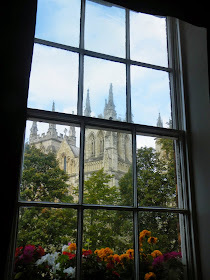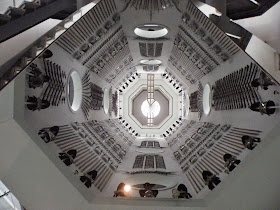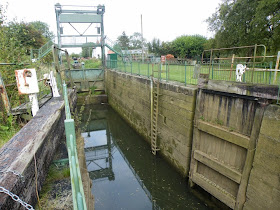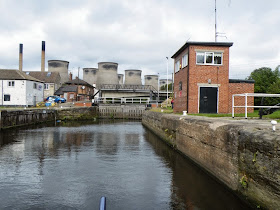Last Sunday we headed back down the River Derwent to moor on the floating pontoon by Barmby Barrage where boats can get out onto the tidal River Ouse. We spent two nights here chiefly because we had to wait for the Spring Tides to recede but also so that we could repaint the gunwales of Leo which have taken a battering in the many locks we have used this year. On Tuesday at 1.30 pm we went through Barmby Lock to catch the end of the flood tide for the six miles up to Selby.
Here is the view looking back from the tidal river to the lock at Barmby.
We covered the six miles to Selby in less than an hour but despite such a turn of speed we were overtaken by these two cruisers which had come from further down the river, perhaps Goole or Hull. They carried on up river from Selby to Naburn so we didn't see them again.
Unlike our journey down, the sun shone and it was pretty warm. Here are the shadows of both of us on the water. Notice how brown and muddy the water is when stirred up by the tide.
The idea was to arrive at Selby at High Water when there is no flow in the river. Unfortunately it is very hard to predict the precise time of slack high water, so the tide was still running strongly upstream. We had to turn 180 degrees and 'stem' the tide before turning into the lock under nearly full throttle, narrowly missing the downstream wall. Phew! Here we are moored off the tide above Selby Lock.
On Tuesday afternoon we had a proper look round Selby Abbey. This is a truly magnificent and huge Norman cathedral. We were very impressed.
After the Abbey was built in the 1100s the tower subsided and you can see the effect of this on the right hand arch.
This ornate but not exceptional capital on a small column in the North Aisle hides a secret.
Inside the carvings you can see above, is this tiny carving of King Edward VII. What he is doing inside and the story behind the carving we were unable to discover but it is rather fun. A torch on a chain is provided so that visitors don't miss the carving.
Last year I found lots of fun epitaphs in graveyards. I've struggled to find many this year, but I did like this one as a memorial to a gravedigger.
There are lots of new stone carvings around the Abbey mostly restoring what was there before. However they have stayed right up to date as this is John Sentamu, the present Archbishop of York who was only enthroned in 2005.
After we'd looked round the Abbey we retired for tea and cakes to Weatheralls, a department store opposite. Here is the view of the Abbey from our tea table.
A pleasant five mile potter along the Selby Canal on Wednesday took us to West Haddlesey where we made use of the lovely mooring we had seen on the way up. We spent the afternoon out cycling around the local villages and had lunch in the Jug in Chapel Haddlesey. We saw the narrow channel of the tidal River Aire below the weir at Chapel Haddlesey. There was a small boat further down but it doesn't look very navigable for a 57 foot narrowboat.
On Thursday we retraced our steps to Castleford where the Rivers Aire and Calder join. There is a saying about the girls of Castleford which runs like this: "The lassies of Castleford are bonny and fair. They wash in the Calder and rinse in the Aire"
It was a very grey and murky day on Thursday, so not many photos and the three power stations of Drax, Eggborough and Ferrybridge, were less obvious than they usually are. Here is the view behind the modern bridge of the old bridge which carried the A1 at Ferrybridge.
Here is Leo moored at Castleford. Please notice the brilliant black gunwale as a result of the two days at Barmby.
Yesterday we came up the River Aire and the Aire and Calder Navigation into the centre of Leeds.
The locks on this navigation are huge as there used to be significant commercial traffic up here. Woodlesford Lock seen here is beautifully kept. I'm not sure of the origin of the wooden donkey but clearly he has a habit of wandering as he is now chained to the lock sign.
This is like something from the Hitchcock film, The Birds. I think they are starlings gathering to fly off for the winter.
Next to Clarence Dock where we moored is the National Armouries. The stairs go round a central tower which is used to display swords and armour. This is a wonderful display. The Museum is free and really well worth a visit.
You can see Leo moored just behind the yellow water taxi. The building behind is the Armouries.
The section of the Leeds and Liverpool Canal going up through the outskirts of Leeds has a very poor reputation for disreputable youths causing trouble to boaters. We followed advice and went through in the early morning. So this morning we set off at 6.45 a.m. just as it was getting light, up the River Aire to River Lock where the Canal begins.
Leo here is coming up in River Lock (which is a deep one at more than 11 feet). Behind Leo is Granary Wharf next to Leeds Central Station.
We've come up 13 locks today which includes one double staircase and two triples. This picture is taken in the middle of the three locks in the staircase at Forge Locks. Both Forge and Newlay Locks (both triples) had lock keepers. Previously we have been on our own with these.
The Leeds and Liverpool is also famous for its many swing bridges. Here was the first of four today, Ross Mill Swing Bridge. Some of them are very difficult to open, so Helen is often on the look out for passers by to help. A motorcyclist helped with a later one.
There are some strange folk in Yorkshire!! These little people were down the bottom of a waterside garden in Rodley.
We are moored tonight out in much more open country beyond Rodley with views, unfortunately through the drizzle, of fields, cows and distant church spires. Tomorrow and Monday we press on towards Skipton where we are leaving Leo for the winter, so our travels are nearly over for this year, sob, sob. Still we have the delights of the Bingley Three and Five Rise Locks to look forward to before we get there.


































































